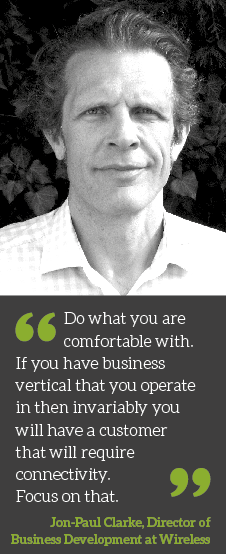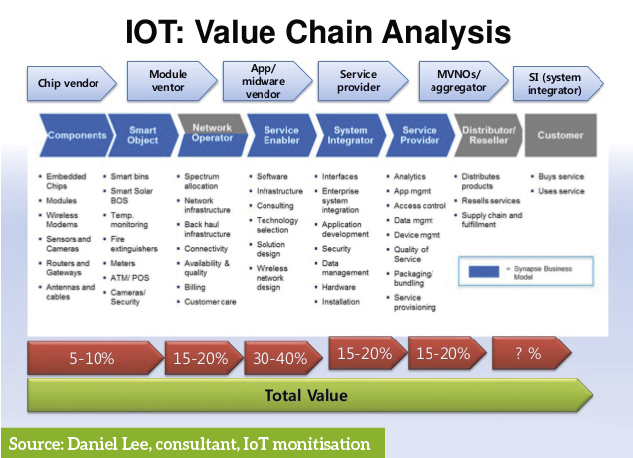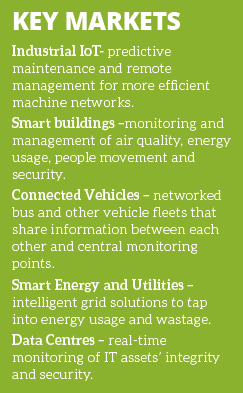
Talking to the Channel about the Internet of Things has previously involved a lot of blank looks and a whole host of terminology which has needed to be carefully defined. After the last Convergence Summit South exhibition it would seem those blank looks are now starting to convert into genuine interest in the IoT space. The suppliers pushing this agenda at the show were rushed off their feet and the seminars discussing where the Channel fits in were full.
 On the current state of the Channel and their involvement in IoT, Nick Sacke, Head of IoT and Products at Comms365, commented, “So far, the telecom channel’s involvement in IoT has been focused on, and limited to, the connectivity layer, in particular M2M data SIMs. This may be down to a tactical shift and re-badging of existing M2M connectivity programmes as ‘IoT’. However, are now starting to view IoT as an end-to-end solution comprising sensors, gateways, network backhaul, data analytics, alerting – and in some cases, control of the devices or ‘things’. The channel is now opening up to the possibilities of these other monetisable elements, and the more encompassing nature of an IoT project solution. Big hardware technology vendors such as Cisco have set out their solutions stall and are re-invigorating their channel. Cloud software and infrastructure vendors such as Amazon, IBM, Microsoft, ThingWorx and others are now offering application development and control platforms with sophisticated data analytics services, well suited for their IT channel to promote and sell.”
On the current state of the Channel and their involvement in IoT, Nick Sacke, Head of IoT and Products at Comms365, commented, “So far, the telecom channel’s involvement in IoT has been focused on, and limited to, the connectivity layer, in particular M2M data SIMs. This may be down to a tactical shift and re-badging of existing M2M connectivity programmes as ‘IoT’. However, are now starting to view IoT as an end-to-end solution comprising sensors, gateways, network backhaul, data analytics, alerting – and in some cases, control of the devices or ‘things’. The channel is now opening up to the possibilities of these other monetisable elements, and the more encompassing nature of an IoT project solution. Big hardware technology vendors such as Cisco have set out their solutions stall and are re-invigorating their channel. Cloud software and infrastructure vendors such as Amazon, IBM, Microsoft, ThingWorx and others are now offering application development and control platforms with sophisticated data analytics services, well suited for their IT channel to promote and sell.”
Dan Cunliffe, MD of Pangea, added “The requests for quotes we are receiving has only improved for us over the last twelve months. I think partners are still driven by the data sell because it’s easier for them and they understand it. We are trying to get them away from that by adding more value around the data sell with some killer products which will buy them extra revenue. So for example, if something gives them £100 over the term and they manage to do certain things they then get £150.”
Ian Stewart, Director of Channel & Propositions at Arqiva, added “The market is completely polarised still. You have a small number of very large volume opportunities. You then have a spread across all sorts of solutions and sectors. It’s not changing as quickly as everyone would like it to because for the majority of product and service companies it’s not about technology or connectivity. It’s about digitising their operational and business models and the sheer change which is required. Uncertainty seems to be hampering volume adoption. What you have outside of the small number of big trading opportunities is a real mixed bag of proof of technology, proof of concept and commercial scale trials as people try and understand the value case.”
Stewart continues, “The reality is there are too many people chasing the digital nirvana when it comes to IoT and the digital worlds. The demand and opportunities are coming from how partners can drive operational excellence or cost savings. The challenge is you need to understand the business you are selling into.”
For partners looking to get into IoT it’s important they don’t run before they can walk. Whilst partners build their knowledge base and learn to identify opportunities an initial bad experience can leave a sour taste in the mouth. It’s important for partners to think carefully about what they do from the outset and target customers they already have a good relationship with.
Jon-Paul Clarke, Director of Business Development at Wireless Logic, commented “A lot of the dealer partners that we work with in the early days were looking for volume but don’t have the technical capability to deliver at scale. For many that sell mobile the next logical step that they understand is something along the lines of taxi dispatch systems. We have a lot of people selling into the taxi market but ironically this is a terrible market to service because it is just a commodity, it’s all public KPN, there is no value you can add and they are shocking payers.
If someone is buying a 10 Meg back up SIM, a 100 Meg primary SIM and suddenly there is a bill for £3k that the customer won’t pay for … In the early days partners need to careful they don’t get bitten.”
Julie Williams, EMEA Marketing Manager at Advantech B+B SmartWorx, agrees, “That’s a key point. We have also found that if a partner gets it wrong initially it can really put them off. Then getting them back to the table can be challenging.”
 Anton Le Saux, Head of M2M at Zest4, commented “I had a partner that uncovered an opportunity in the healthcare market recently with cancer treatment and monitoring of a piece of equipment. He wanted to know where to start and his initial reaction was to throw the opportunity over us and he said he would try the next one. Before he had even got into the market there was that fear because didn’t want to talk to his customer, which he provided other services to, about things he didn’t understand properly. Jumping into the unknown is daunting for anyone that has managed to build up their business, suddenly the risk of looking like you don’t know what you are talking about seems too great. So how should partners get started in IoT?
Anton Le Saux, Head of M2M at Zest4, commented “I had a partner that uncovered an opportunity in the healthcare market recently with cancer treatment and monitoring of a piece of equipment. He wanted to know where to start and his initial reaction was to throw the opportunity over us and he said he would try the next one. Before he had even got into the market there was that fear because didn’t want to talk to his customer, which he provided other services to, about things he didn’t understand properly. Jumping into the unknown is daunting for anyone that has managed to build up their business, suddenly the risk of looking like you don’t know what you are talking about seems too great. So how should partners get started in IoT?
Jon-Paul Clarke says “Do what you are comfortable with. If you have business vertical that you operate in then invariably you will have a customer that will require connectivity. Focus on that. Unified Comms tends to be that router proposition with the DSL failover and the rapid deployment capability. The approach we take is right from the first deal where you hold the hand of the partner and go along to all the meetings and take part in calls.“
He continues, “Usually the salesman dealing with these people is used to saying ‘I can save you x on these calls’ and ‘I can save you y on this product’. In M2M and IoT conversations price is not mentioned and the partners introduce Wireless Logic as their IoT experts and conversations centre around enablement of their business and what we can achieve for them. When you have that buy-in, the partners see the process, and as soon as they see revenue generated that is when they allow you access to the customer alongside them.”
Digesting the IoT Opportunity
As soon as you start to scratch beneath the surface of IoT then potential opportunities start to swamp the mind. The opportunities are so vast that it would be impractical to try and swallow the whole IoT beast whole.
Lorrin White, MD at Bamboo Technology, says, “Looking across the marketplace, people are reporting great success with both horizontal and vertical plays. The important thing though is to decide what kind of player you are; and focus on this. The world of IoT is far too big to try and cover everything at once.
 Lorrin continued, “The diversity of the channel means we are seeing our partners discovering and winning business from virtually all sectors; although the largest currently is in vehicle telematics (representing around 90% of our base). We work with various organisations from resellers and system integrators to in-house-solution providers. They already have great solutions and taking the M2M connectivity piece simply adds to their offering.”
Lorrin continued, “The diversity of the channel means we are seeing our partners discovering and winning business from virtually all sectors; although the largest currently is in vehicle telematics (representing around 90% of our base). We work with various organisations from resellers and system integrators to in-house-solution providers. They already have great solutions and taking the M2M connectivity piece simply adds to their offering.”
Martin Taylor, CMO at Content Guru “Things are just setting off down the line with M2M. In some enterprise deployments, initial steps to productize M2M have seen it begin to be integrated with Customer Engagement Hub capabilities, such as contact centre-style reporting on IoT activities, or real-time SMS alerting through multi-channel platforms. This results in greater efficiency, connectivity and contextualisation, and enables users to rapidly visualise patterns and predict behaviour. But so far we have just scratched the surface of M2M’s transformative capabilities. Really only a bespoke solution at the moment, it is not yet a standard product that can be sold in any volume. While its ultimate potential is tremendous, especially with the huge benefits brought to healthcare by telemetry and wearable tech, we are still very much in the education phase.”
Cunliffe says start with what you have already got and work from there, “We got one of our traditional mobile customers to list their customers with 10 or more vehicles in their fleet. We then started at the top of the list and worked our way down. They got a decent hit rate and managed to convert three of them pretty quickly, we now have a specialist that works on our vehicle product.”
Commission Structures and Value Chain Considerations
We have seen it time and time again in the Channel, if you want to sell something you MUST incentivise your sales people to go out there and get the deals done. If you are majoring on connectivity in the M2M space then giving your sales people a fraction of the incoming revenue each month probably won’t cut the mustard.
Dan Cunliffe agrees, “I think the sales guys are driven by exactly what their target is. It is important to find out what that is and how it works for your customers. For me, it’s not just about making the data sell, sometimes you just have to do the introduction or know the right person. Suddenly that has a really big impact, £5m IoT deals are not uncommon (for the whole piece) and if 5% of that goes towards your sales target then suddenly that has a huge impact.”
 Jon-Paul added, “We have a customer in the UK who pays its salesman based on the revenue generated over the length of the contract. If they have x number of devices multiplied by the contract term then suddenly the salesmen are finding they are hitting their targets without having to do much to get there. Wireless Logic went out and sold the solution for them, cc’d them in on the emails and agreed the commercial model, and that was it. Those guys love it.”
Jon-Paul added, “We have a customer in the UK who pays its salesman based on the revenue generated over the length of the contract. If they have x number of devices multiplied by the contract term then suddenly the salesmen are finding they are hitting their targets without having to do much to get there. Wireless Logic went out and sold the solution for them, cc’d them in on the emails and agreed the commercial model, and that was it. Those guys love it.”
Getting paid in IoT has a lot to do with how much of the value chain you control. Unless you happen to land one of the very few ‘mega-deals’ with hundreds of thousands of connections resellers need to be careful they don’t end up taking a small cut of a small monthly revenue stream. Channel partners invariably control the end customers and so they must broaden their vision when looking at IoT deals. Hardware is often a great place to make margin during the install phase as well as remembering all the added benefits that come along with selling a long term contract into a customer.
Le Saux stated, “IoT helps partners secure their core business too, i.e. the stuff that got them in the door in the first place. When they have this long term solution in place the core business will likely stay in there as well. Otherwise that core business is always at risk from competitors.”
Sacke comments, “In addition to network backhaul data SIM sales, we recommend resellers develop a focus in the edge of the network – sensors, device modules, gateways, and data analytics at the edge of the network. This offers additional revenue stream potential in hardware, software and professional services.”
Ed Says… Should you be looking at IoT? Yes, absolutely. The problem many partners may be having is they are looking at IoT like they need to deploy huge SIM estates and to only make a fraction of the revenue generated. The truth is that the market has moved on, there are products being developed that the reseller channel will be able to sell almost immediately. It is really important that partners don’t let the apparent complexity in the market put them off. There are easy to execute solutions available which can act as a good toe dipping exercise. From there a more extensive portfolio can be built. However, I agree with Ian Stewart from Arqiva, understanding the business value of IoT is essential for the Channel to maximise the opportunity. By knowing your customers and their processes the true value of IoT will be unlocked. One thing is for certain, IoT opportunities aren’t just going to fall into your lap unless you are clued up and looking. Partnerships are going to remain crtical to success so a good place to start would be having a chat with the growing list of suppliers. You will find some of them in this article.

